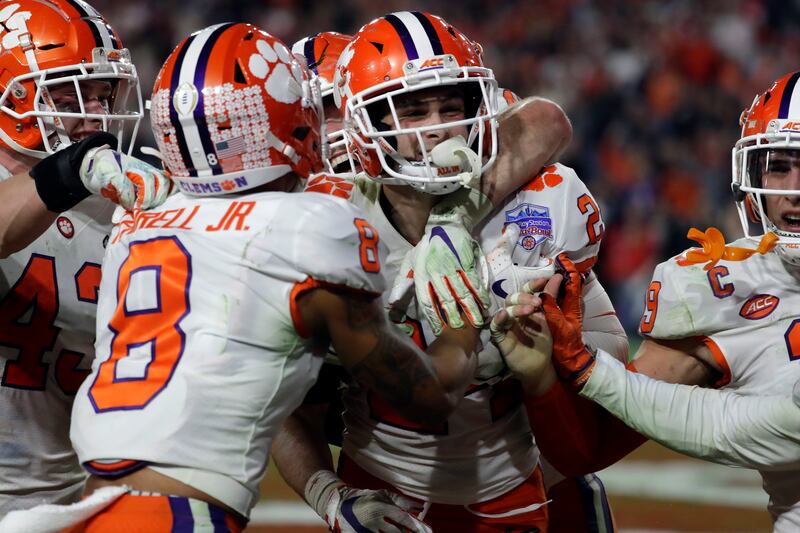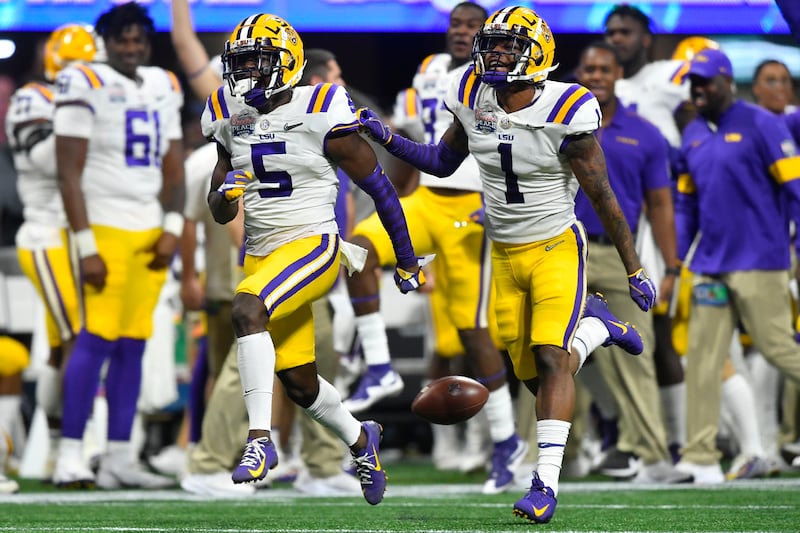SALT LAKE CITY — All manner of statistics will likely grace the screen during the college football title game Monday, from 48.9 points per game scored by LSU’s nation-leading offense to 11.5 points per game allowed by Clemson’s top-rated defense. Keep watching and you might even see the GPAs of a couple of standout students — like last year, when Clemson defensive lineman Christian Wilkins was honored as the nation’s top scholar-athlete. One stat you’re unlikely to see, though, is the graduation rate for student-athletes at either school.
According to the Department of Education, that would be 19% for LSU’s football program and 25% for Clemson’s. There are several ways to measure graduation rates, but what’s clear is big-time college football programs often lag behind their less-successful peers when it comes to academics.
College sports, in theory, are an entertaining part of the student experience and, for some, an avenue to a college degree. But at top football programs, where athletes, coaches and institutions face competing pressures to win and sell tickets without sacrificing academics, disparities in graduation rates call into question just how much is being sacrificed.
“In my opinion,” said college athletes rights advocate Richard Johnson, “the Power Five football and basketball teams are not collegiate teams. They don’t include enough full-time, real college students to warrant being labeled a college team, and they should be paid. And it all circles back to the graduation rate.”
Why is this complicated
On the other hand, you might see recent reports that 81% of Clemson players graduated over a four-year period, along with 71% of of LSU’s players. That’s because graduation rates are measured in several different ways.
The Federal Graduation Rate counts just about anyone who didn’t graduate — even if they transferred and graduated elsewhere — against the final percentage.
The NCAA prefers an athlete-specific metric, the Graduation Success Rate, which removes anyone who transferred or left school in good academic standing from the cohort, often resulting in higher percentages.
Confused?

Richard Southall, director of the University of South Carolina’s College Sport Research Institute, says you’re not alone. In a 2011 story in Athletic Business, he said he’s been compelled to reach out when media organizations incorrectly report athletes graduate at a higher rate than their nonathlete peers.
“You cannot make that statement because the Graduation Success Rate is not the same metric as is used for the general student population,” he told Athletic Business, because again, the Graduation Success Rate applies only to athletes. “Reporters confuse the GSR and the FGR just like the general public does.”
As University of Colorado finance professor Woody Eckard wrote in an email, “Welcome to the arcane world of college athlete graduation rates.”
Let’s simplify. Instead of using the aforementioned methods, we’ll use a metric developed by Southall and his colleagues called the adjusted graduation gap, or AGG.
This measurement doesn’t tell you what percentage of players graduated from a particular school in a given year or years, but it allows comparisons between various groupings — like teams in the Pac-12, the Power Five, etc. The result is a number that tells you how well a group of programs — for example, the top-10 College Football Playoff teams — are doing in school compared to regular students at those same schools, expressed as a positive or negative percentage.
Spoiler: They’re not doing well.
What’s happening
You’ll find the largest gap at the very top. Among last year’s final top-10, the AGG was -25.5, meaning those teams’ graduation rates were 25.5 percentage points worse than the overall graduation rates of their respective student bodies. The most recent AGG report argues the discrepancy among top-10 teams shouldn’t be surprising “given their nearly singular focus on qualifying for the College Football Playoff.”
Among programs ranked 11th through 25th, the AGG was -9.2 — better, though not ideal.
Graduation rates matter, of course, in part because the NCAA’s bylaws stipulate participation in college sports must be “an integral part of the student-athlete’s educational experience.” In other words, college sports should enhance an athlete’s college education, not replace it as the top priority.
Last year, 103 undergraduates left school early for the NFL draft. Southall points out that players leaving early to pursue tens of millions often isn’t bad for them.
“There’s no reason in the world that you can’t go back and get your degree. It’s disingenuous for people to say these players should stay,” he said. But he added it’s also disingenuous for the NCAA to claim that every level of its enterprise is about education first when confronted with such figures.
“That’s why we differentiate between the Power Five schools, FBS, FCS,” Southall said. “At different levels, college sport is not the same.”
Athletic success vs. education
Johnson tweeted in late December that because of similar statistics, Monday’s championship “will literally have nothing to do with good-faith college athletes.” Such athletes would be those who are in school to graduate and who happen to play football.
“The predicate to be on the team is you have to be enrolled as a full-time student, you have to intend to graduate,” he said. “When you have graduation rates as low as these teams’ are, they cannot in good faith claim to be real students on a macro basis.”
That’s not to say the chance to earn a free college degree isn’t a good opportunity, and some take it seriously. Former Colts quarterback Andrew Luck, for example, returned to Stanford to finish his architecture degree even though he likely would have been the NFL’s first-overall pick a year earlier.
But for players like Luck, who take their education seriously and want to pursue a degree, the numbers beg the question of whether playing at the best college football programs is the best option. Being the best at anything — especially something as competitive and lucrative as college football — requires prioritization. If one program isn’t putting football first, chances are another of the 130 FBS teams is.
Do the math: Full-time students must carry at least 12 credit hours — that’s 12 hours per work in class, plus 24 hours of homework per week. The NCAA allows 20 hours of practice per week, so that’s (at least) how much is happening. And even more is expected from players on title-level teams, as far as personal workouts, meetings and film study — sometimes at outrageous hours — not to mention travel.
“There is probably no more significant roadblock for college athletes seeking a meaningful education than the unreasonable amount of time they are required to engage in practice and other athletics-related activities,” Allen Sack and Gerald Gurney wrote for Inside Higher Ed in 2016.
Meanwhile, at the top level, universities make tens of millions in revenue from their college football programs. The most recent data shows Clemson’s football revenue in 2017 totaled $612,117.61 per each of its 85 scholarship players, while LSU’s revenue exceeded $1 million per scholarship player.
There’s little question that these and other universities encourage their football players to graduate; the NCAA incentivizes them to do so, and they often go to great lengths via facilities and tutoring. But at the top level, when the data shows many players aren’t, it’s questionable at best whether competing at college football’s highest level is compatible with the NCAA’s supposed mission.


